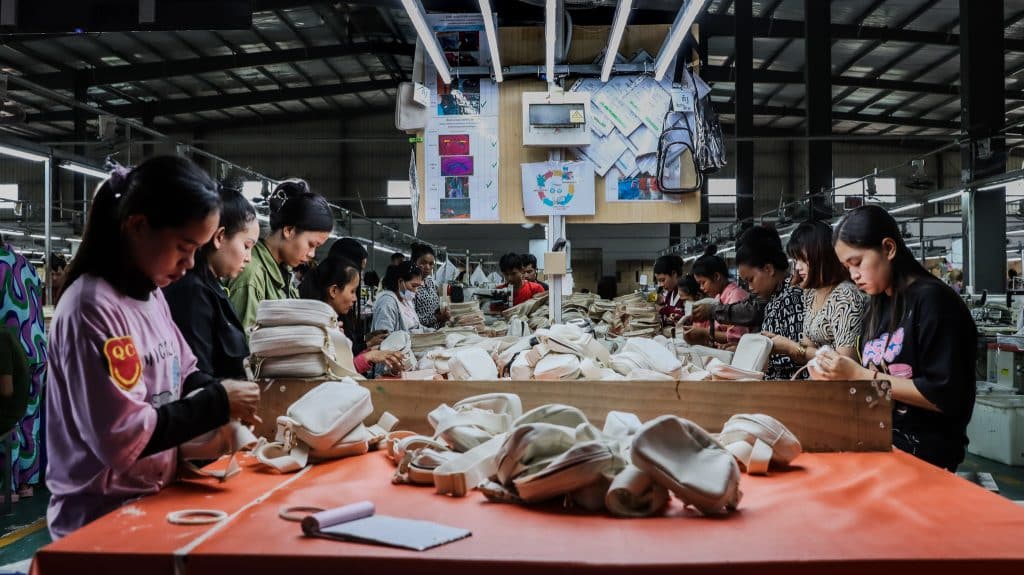In early 2023, within the bustling special economic zone of Sihanoukville—a coastal province in Cambodia where over 30 factories operate—digital wage payments were seldom used. Today, around 50 percent of these factories have embraced this method of wage payments, making a decisive impact on the lives of over 8,000 workers, most of whom are women. Nimul and Navy who both work for a garment factory in Sihanoukville offer a glimpse into how this transition is reshaping their daily lives.
Environment conducive to transition
Sihanoukville’s transition to digital wage payments was initially slower than in other regions in the country. Just a year ago, most factories were entrenched in cash-based wage payments, rife with inefficiencies and security risks. The recent development of digital financial infrastructure combined with stakeholder engagement and factory and worker training, have made the transition possible. Today, digital wage adoption is not just an operational shift in Sihanoukville but a strategic response to the growing complexities and costs of payroll as factories expand. It also offers a much safer way for workers to receive their wages. Factories such as Yinxing and Walt Technology have proven that the adoption of digital payments yields tangible benefits such as increased transparency, security, and convenience.
Yinxing Factory, employing 800 workers, embarked on its digital wage journey in partnership with a local financial service provider. Inspired by training and subsequent sharing workshop on responsible wage digitization conducted by the ILO-Better Factories Cambodia (BFC) and the Textile, Apparel, Footwear & Travel Goods Association (TAFTAC) in September 2022 and April 2023, the factory implemented a transition over four months after the training, ensuring a smooth and gradual adoption and a minimal disruption to workers’ lives.
Beyond Just Wages


For Nimul, a Quality Controller at Yinxing, this change has been more than a simple switch in payment methods; it has been an efficiency upgrade. “I used to travel back and forth (to my hometown) on paydays, which was a scary experience for me, carrying a large amount of cash,” she recalls. Digital wage payments have enabled Nimul to regularly send remittances to her family to support her young daughter who stayed behind in Kampot, eliminating the need to have frequent and costly travels or cash transfers. This change not only eases her financial responsibilities but also allows her to concentrate more on her work.

Similarly, Navy, a 22-year-old worker in the fabric gluing section, has seen her life transformed by this digital transition. Once dependent on cash transactions, Navy now leverages digital payments to handle her daily expenses. “I use the app not just to send money but also to pay for utilities, buy groceries, and even shop for clothes,” she says. The digital wage system has integrated seamlessly into her life, enabling her to save more effectively. “I can see records of my spending via the app, which helps me manage my finances better,” Navy adds. For Nimul and Navy, this shift towards digital payments translates into greater productivity at work and financial empowerment, reinforcing the value of the digital wage payment method.
Benefits for Factories: Efficiency and Business Relationship

A few blocks away from Yinxing, Walt Technology is another factory that has fully benefitted from its transition to digital wages. From fewer than 100 workers in 2019 to 1,300 in 2023, the factory’s adoption of digital wages was a strategic decision aligned with growth, risk mitigation, and operational efficiency. “We saw this transition as a step toward modernizing our operations,” shared Joel, Walt’s finance manager. By streamlining wage payment systems, the company has minimized human error and improved efficiency, reducing payroll preparation time from 2-3 days with a team of 4 people to just a few hours, without disrupting the factory floor on payday. Joel also noted that the switch was well received by brands.
Looking Ahead: Digital Wages as Common Practice
These testimonials are representative of a broader shift within the province and across Cambodia’s garment sector. Today, over half a million garment workers, most of whom are women, receive their wages digitally through financial institutions. However, despite this progress, more than 25 percent of the 703 factories covered by Better Factories Cambodia (BFC) have yet to adopt digital wage payments, affecting roughly 100,000 workers. As the overall sector counts 1,326 factories[1], the actual number of factories still relying on cash wages is likely to be higher. The hesitation to transition to digital wages is often due to factors such as a lack of knowledge about managing the transition, perceived lesser benefits for smaller factories, workers’ preference for cash, and limited access to digital financial infrastructure in certain areas.
As more factories and stakeholders collaborate with BFC, TAFTAC and the ILO’s Global Centre on Digital Wages for Decent Work, the momentum for digital wages is set to continue. This shift is not only transforming how wages are paid in Cambodia’s garment sector but also reducing security risks, improving productivity, and improving garment workers’ control over their wages and financial wellbeing. As the industry continues to evolve, digital wages, when provided responsibly, will undoubtedly play a critical role in shaping a more inclusive and productive future for Cambodia’s workforce.
[1] Ministry of Labour and Vocational Training (2023)